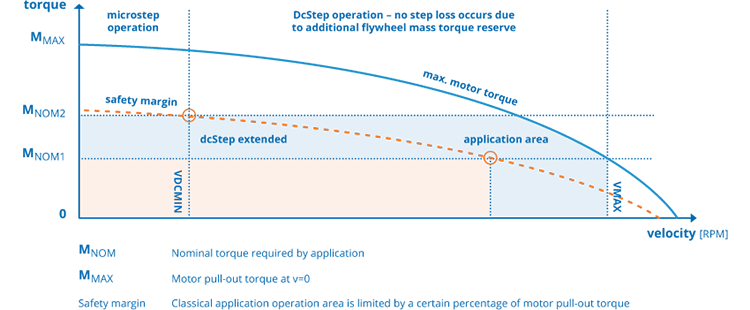Optimizing Torque Output with DcStep Technology
DcStep™ is a highly efficient stepper motor commutation scheme from Analog Devices, Inc. (ADI) Trinamic family, which aims to use most of the available output torque of a stepper motor at 80% of the maximum pull-out torque. Effectively, DcStep technology provides extra torque to match sudden increases in load resistance while uniquely maintaining position counter integrity.
DcStep technology closes the gap between fully featured closed-loop stepper drives and cost-efficient open-loop systems. Optimizing torque output with DcStep technology can help improve safety margins and ensure your applications reach the target position without losing a step.
How Does DcStep Technology Work?
Stepper motors are typically used with a safety margin of 40% to 50% of their maximum pull-out torque. This margin is needed to compensate for unforeseen load peaks, torque loss due to resonance, and aging of mechanical components in an open-loop system. Furthermore, stepper motors have a decreased torque at higher speeds caused by the specific dependency of rotor velocity and back-EMF.
To ensure a stepper motor doesn’t lose steps when the load becomes too high, this sensorless technology uses most of the available output torque at about 80% of the stepper motor. It gives the stepper a DC motor-like behavior if the load exceeds the motor output torque for the actual working point, automatically adapting the motor velocity to the actual motor load by moving along the shape of the stepper motor’s torque curve.

DcStep technology is used at middle and higher velocities where the back-EMF significantly affects motor coil current and maximum output torque. For a given setup and application, the stepper motor technology extends the motor’s functional area by either allowing for more torque output at the same velocity or by increasing the maximum velocity. This allows engineers to use more SWaP-effective stepper motors with the same results.
DcStep Technology Adds DC Motor Characteristics to Your Stepper Motor Drive
While most open-loop stepper motor drives lose steps in an overload situation, DcStep drives reduce speed instead. The load-dependent speed control automatically adapts the velocity to the actual motor load and moves the motor as fast as possible without losing a step. By doing so, the drive can overcome the resistance from the heavy load situation and thereby maintain position counter integrity. This is similar to a DC motor behavior in terms of energy efficiency. DcStep features furthermore allow for autoramping by adapting the ramping profile to the real-time torque overload condition, making sure the target position is reached.